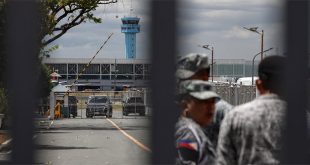BEIRUT | Xinhua | As the ceasefire agreement between Lebanon and Israel took effect at dawn on Wednesday, Jihad Nasrallah, along with thousands of displaced Lebanese, wasted no time. Before sunrise, they gathered their belongings and set out on the long-awaited journey back to their homes in southern Lebanon.
The roads were crowded with returnees, their faces a mixture of joy and lingering sorrow. Many had endured over a year of displacement, their return marked by happiness at reclaiming their homes but also the grief of lost harvests, destroyed properties, and loved ones who perished during the conflict.
“The displaced could hardly sleep, eagerly waiting for dawn,” said Jihad to Xinhua. “There were tears of joy as people bid farewell to each other, and car horns echoed in celebration. ”
In the southeast village of Kfarhamam, most returnees lost their homes due to Israeli bombings. Still, the villagers were unfazed, as their priority, according to the young Hassan Abdul Karim, was to move past their displacement and return to their hometown.
“Displacement is unjust, humiliating, and deeply disturbing,” Abdul Karim told Xinhua. “We’d rather live in tents on the ruins of our homes than remain in school halls, crammed alongside five to eight other families. So we returned, carrying mattresses and blankets on the roofs of our cars.”
The Lebanese army mobilized at first light, deploying bulldozers and trucks to repair roads damaged by airstrikes in the Bekaa Valley and southern Lebanon. Meanwhile, members of the Internal Security Forces managed traffic at key intersections, while medical teams from the Lebanese Red Cross and the Islamic Health Authority stationed themselves at city entrances to handle emergencies.
In the eastern city of Baalbek and the villages of western Bekaa, including Machghara, Sohmor, and Yohmor, returnees faced the devastation of homes and infrastructure caused by relentless airstrikes. Yet, not everyone could go back. Those from villages along the Israeli-Lebanese border were forced to wait, as Israel warned against their return until its forces completed their withdrawal.
Fatima al-Ahmad, displaced from the border village of Wazzani, remains in the Khan market with her livestock, awaiting clearance from the Lebanese army. “We are happy about the ceasefire, but we cannot return until the Israeli forces leave our village,” she told Xinhua.
“We will remain with our livestock, estimated at 3,000 heads of sheep, in the Khan market, waiting for the instructions of the Lebanese army, which will inform us about our return date,” she told Xinhua.
For those who have made it back, the challenges are far from over. In the southern village of Habbariyeh, returnee Riad Issa described the uphill battle ahead. “Rebuilding homes, replanting lands, and restoring life to our villages are monumental tasks, especially with scarce resources and an ongoing economic crisis,” he said.
The most daunting challenge, however, is emotional recovery. “We can rebuild what was destroyed, but the loss of loved ones and the memories of war and displacement will remain etched in our minds forever,” Issa reflected.
 The Independent Uganda: You get the Truth we Pay the Price
The Independent Uganda: You get the Truth we Pay the Price


